A. Lange & Söhne Zeitwerk Minute Repeater And Its Large Digits: Do They Cause Hyperdigitalia?
For your consideration I present: hyperdigitalia (/hī-pər ˈdi-jə-täl-yä/), noun (Latin, Greek).
A visual fixation on exaggerated numerals and digits; preference for atypically large numbers.
“Giant, bold numbers on billboards or advertising tickles my hyperdigitalia. The same goes for super graphics.”
I recently coined the new word amnemori to help me describe a very specific feeling I had experienced when I first saw the new H. Moser & Cie Streamliner. It helped organize my thoughts and give a concrete definition to the feeling so I could share it. Today I coin another term to accomplish the same goal of helping you understand a trait about me that is likely not unique. That word, and that trait, is hyperdigitalia: the fascination with physically large numbers.
Now I don’t mean high-value numbers, but rather physical objects or visual representations of numerical digits that are large in scale and proportion. I love contrast, boldness, and unique juxtapositions, and very large numbers touch on all of those.
We don’t often see numbers on a large scale or as a major visual feature of a design, product, or structure. So when I see a building number painted on the outside wall standing 30 feet tall, it’s visually arresting. With billboards, the scale of text or numbers is usually proportional to the format of the sign, not overpowering and the main visual focus. So when the numbers or characters are exaggerated, or even bleeding off the edge of the billboard, I am drawn to the design.
For that reason, it has become a bit of a fixation of mine to get lost in giant numbers. Along with hyperdigitalia’s sibling word, hypernotalia (a fixation on exaggerated characters, also my creation), they create my compelling connection to a design aesthetic called super graphics.
This is where a name, number, or logo is applied to a surface in a way that it overtakes the space, such as the name of a company painted floor to ceiling along the entire length of one wall. It reminds me of dystopian cityscapes or visual effects in movies where the text is inserted into a landscape, dominating the scene.
That fascination is why I have such a strong affinity for A. Lange & Söhne, because beginning with the Lange 1 and the later Zeitwerk, and now with the new Odysseus, Lange has created a very specific aesthetic around large digital displays. While some may not feel they qualify for the title of super graphics (and I would agree) they are clearly designed to stand out as exaggerated compared to standard date windows, digital hours, or minute displays.
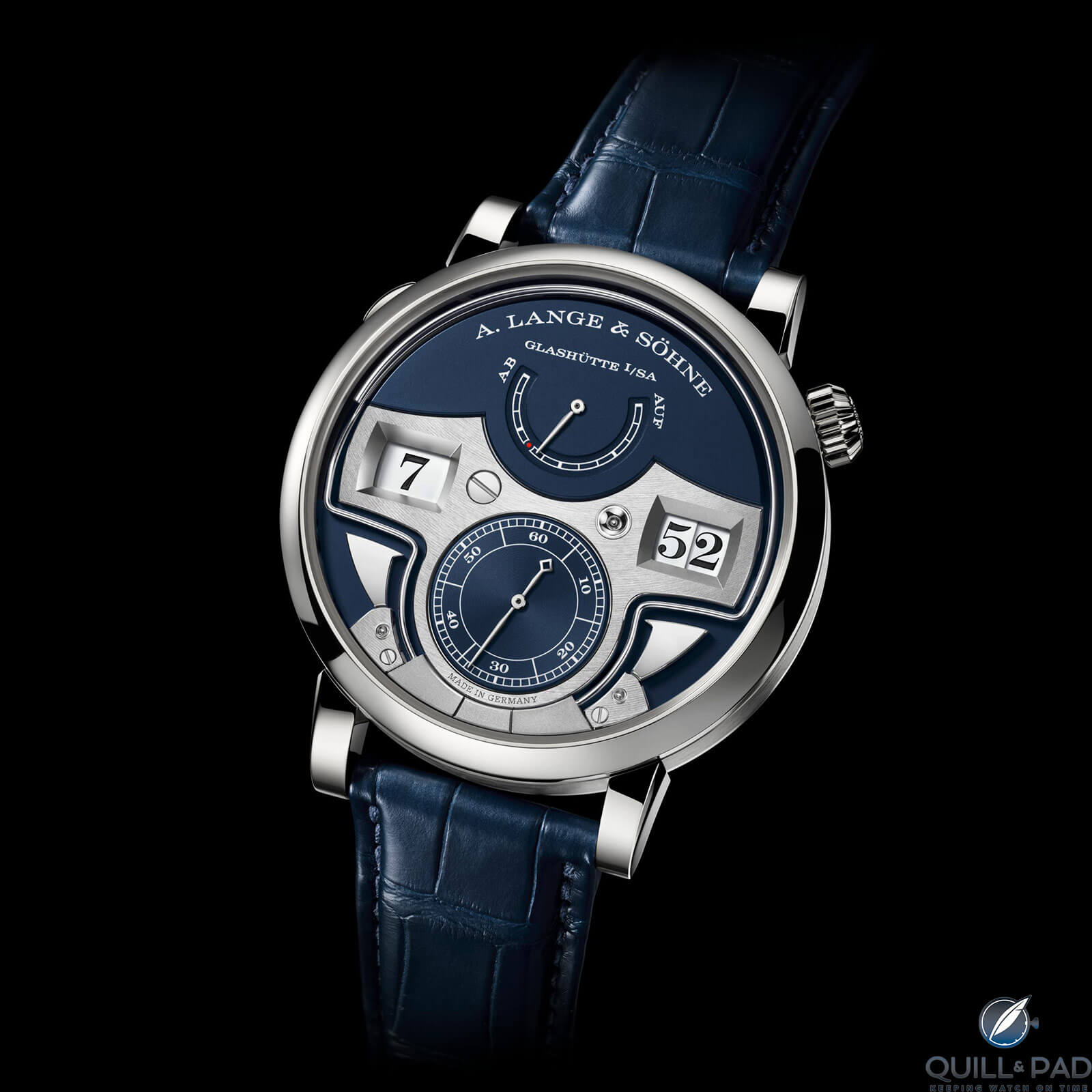
A. Lange & Söhne Zeitwerk Minute Repeater
The latest limited edition of the Zeitwerk Minute Repeater reminded me why I am so fond of the Lange aesthetic. And because I’m more passionate about watchmaking than watches, this new Zeitwerk motivated me to look deeper into large digital displays and how they are alike and how they differ.
A. Lange & Söhne Zeitwerk Minute Repeater
During Watches & Wonders 2020, A. Lange & Söhne released a 30-piece limited edition of its incredible Zeitwerk Minute Repeater in white gold with a deep blue dial. It is a great color combination, though the watch is mechanically the same as its predecessor. This is “simply” a new variation.
This repeating wristwatch is unusual mechanically as well as visually: to begin with, it is a decimal repeater. The Zeitwerk’s mechanical digital display is suited to the rare decimal chime as it is particularly intuitive to read off: you naturally read it left to right just like you would read a book.
To understand the chiming of a decimal minute repeater, you must first understand how a standard minute repeater works: to “hear” the time you must count along with the gongs. A decimal repeater is a far more intuitive system than a traditional minute repeater (though harder to make): it chimes blocks of minutes in units of ten rather than the fifteen/quarters of a conventional minute repeater, just the same way we read them off on a conventional analog watch or clock.
For a full description of this watch, please see A. Lange & Söhne Zeitwerk Minute Repeater: A Decimal Repeater With Attitude!
The new Zeitwerk Minute Repeater is descended from the Zeitwerk design that A. Lange & Söhne shocked the watch world with 21 years ago and that has led to five unique movements. It was arguably at least partially the inspiration for the brand’s other Watches & Wonders 2020 introduction, the Odysseus in white gold.
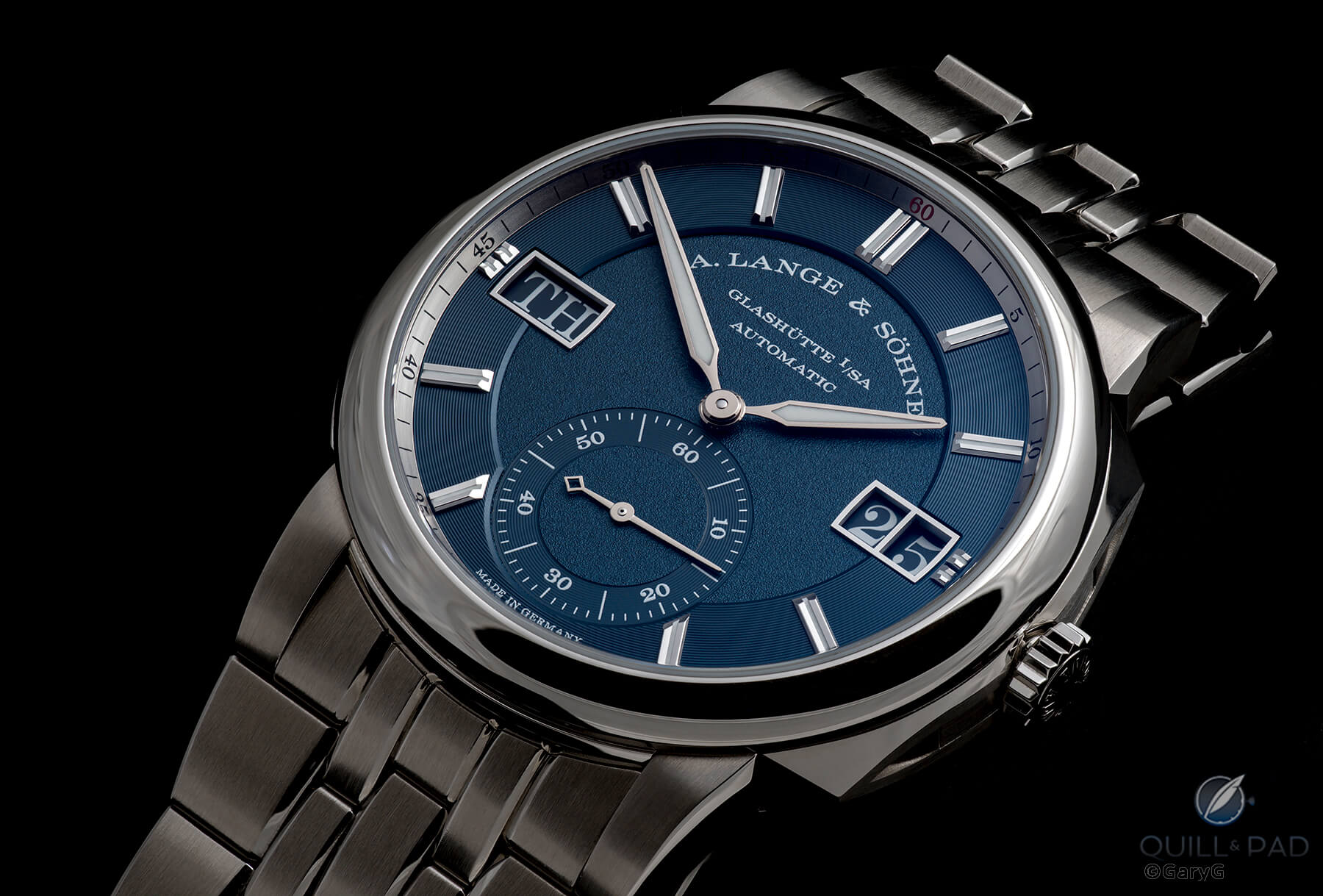
A. Lange & Söhne Odysseus in stainless steel
But even with that, it all wouldn’t have happened if not for what took place back in 1994. During the four years of development rebuilding the brand after the Berlin Wall came down, A. Lange & Söhne filed for its first modern patent – a large date mechanism – which eventually made its way into three of the first four watches that relaunched the brand: the Lange 1, the Saxonia, and the Arkade (now a retired collection) all bore the large date display that has become one of the leading hallmarks of the brand. Only the Tourbillon Pour le Mérite did not; it is now part of the 1815 collection.
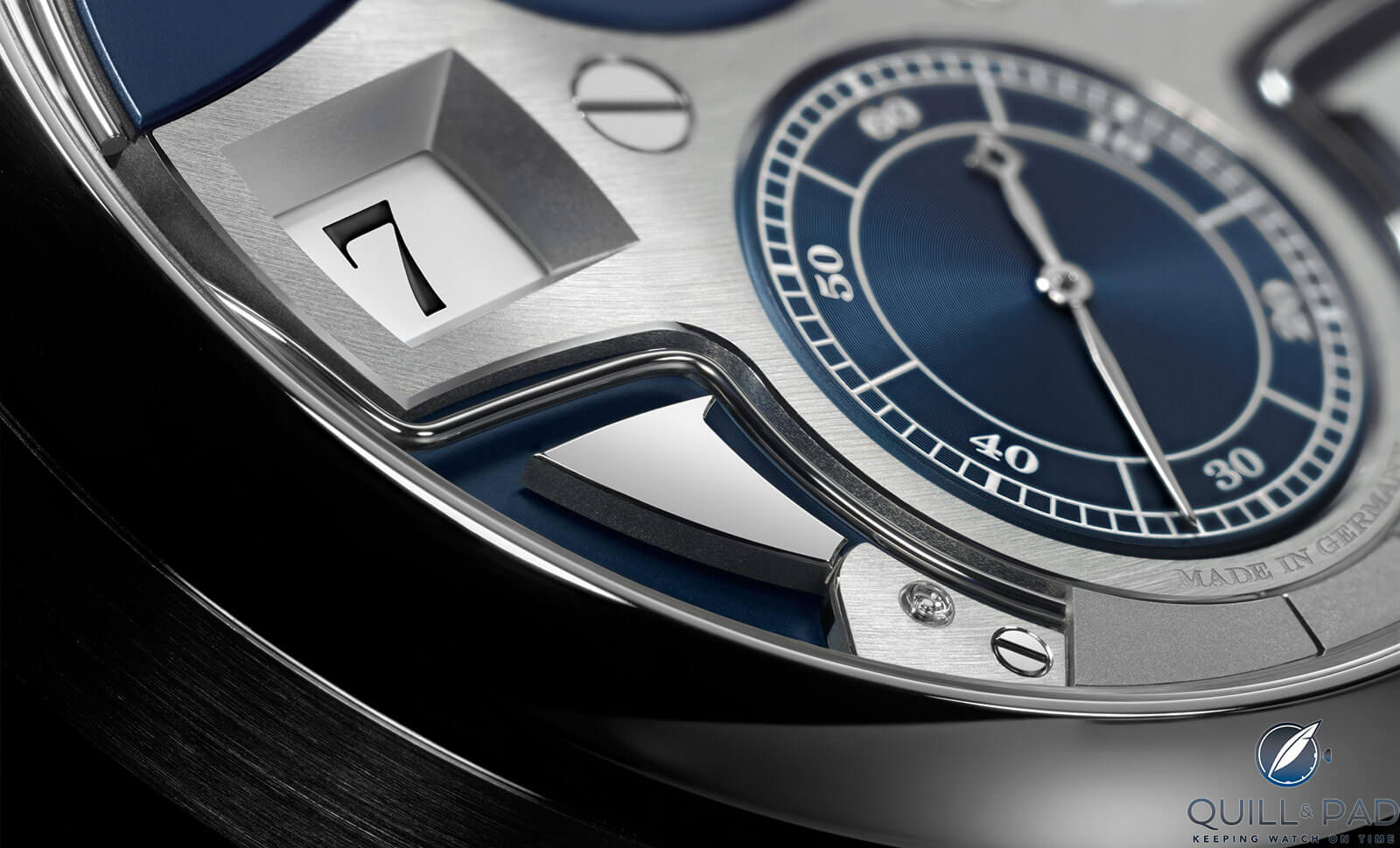
Large hour window and dial-side repeater hammer of the A. Lange & Söhne Zeitwerk Minute Repeater
The large date is currently found in every collection aside from the Zeitwerk and 1815, however, since the Zeitwerk has a large digital time display, it is only the 1815 collection that has no large digital display variations anywhere in the collection.
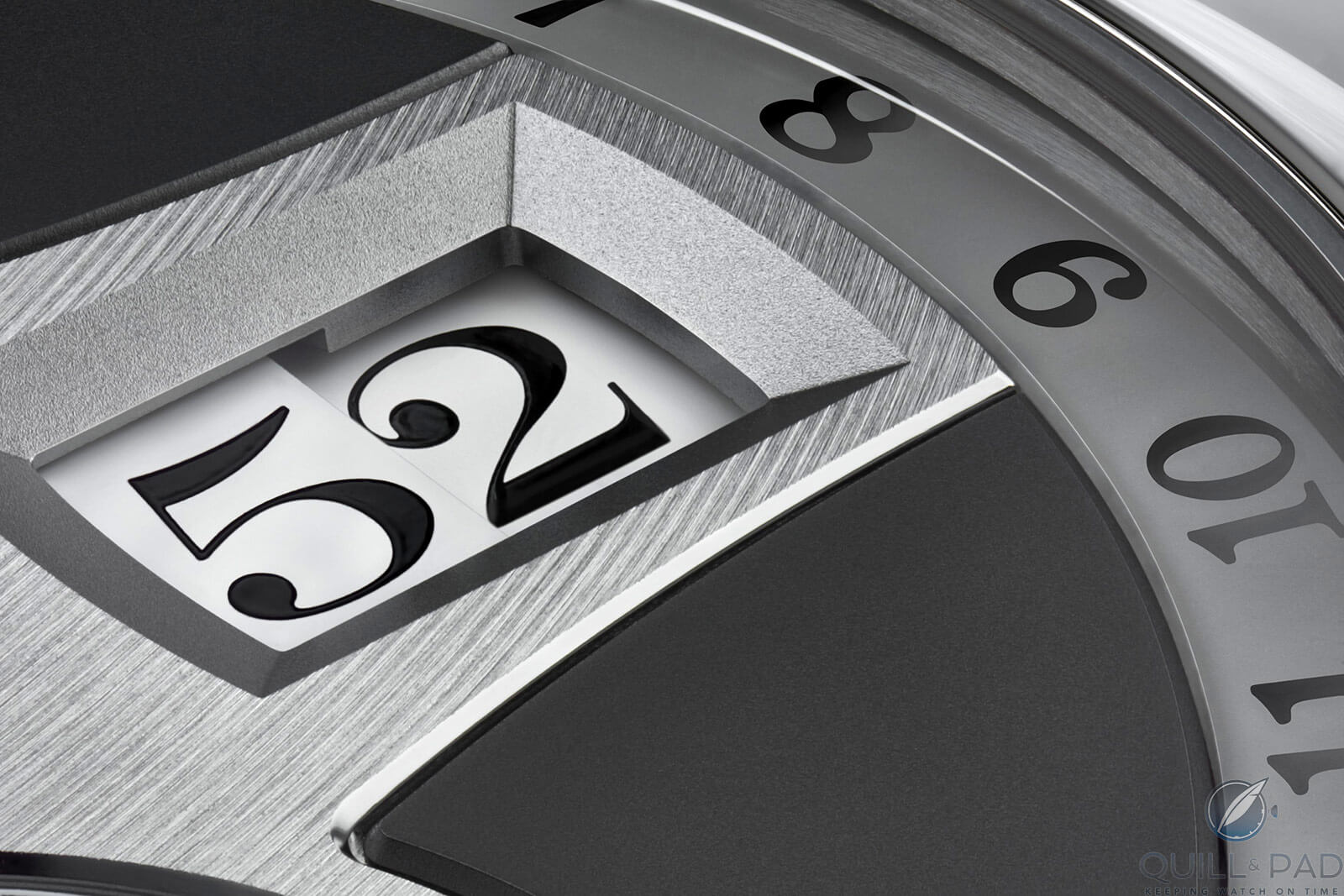
A. Lange & Söhne Zeitwerk Date’s minute display
That is why the large date is a main building block of A. Lange & Söhne “DNA” (I know, I know, that’s a cliché buzzword): it was a bold design decision at the time, and A. Lange & Söhne remains one of very few classical brands to have created a date display larger than a tiny window squished at the edge of the dial.
That aesthetic eventually led to the creation of the Zeitwerk. It was an extension of the mechanical design of the brand’s “outsize date” in some ways, a continuation of the large digital display that had been working so well for the brand. With a large variety of models using this date, and almost half a dozen Zeitwerk models based on the jumping hour and minute mechanism, a mechanical collaboration was in order.
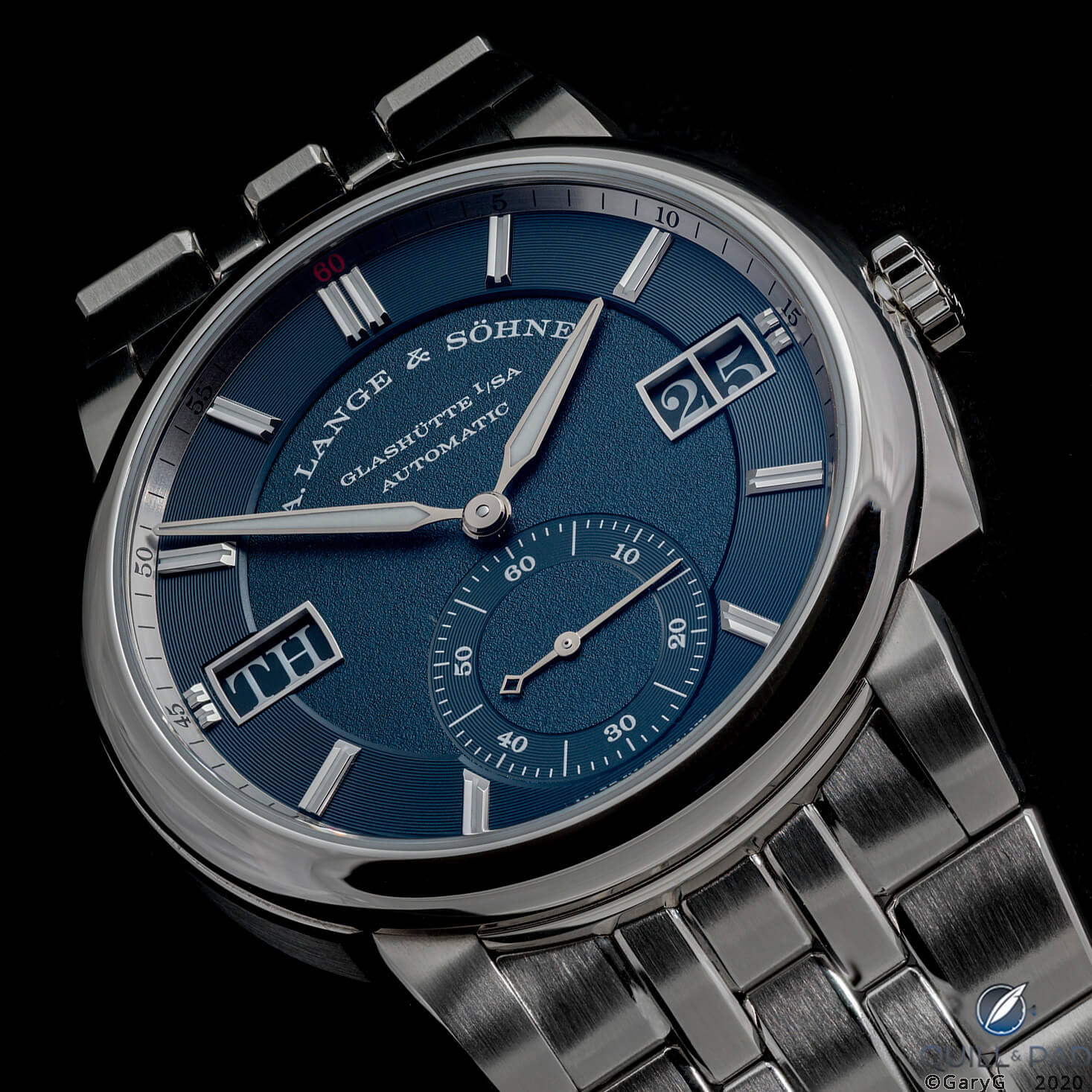
Odysseus day-date watch by A. Lange & Söhne
The Odysseus is the offspring of the large date mechanism and the aesthetic of the Zeitwerk time display as it incorporates day and date displays opposing each other at 9 and 3 o’clock on the dial in the spirit of the Zeitwerk (the same typical framed window style). This collaboration between mechanisms and aesthetics shows the common thread of large digital displays.
Hyperdigitalia
The aesthetic of a large digit within a window has a lot of visual tension with the extremely classic design of the rest of the details on an A. Lange & Söhne. With its strong public reception, it’s clear that implementing it in many pieces is a winning proposition.
But A. Lange & Söhne never rests on its laurels, wanting to make better and more creative watches that exemplify fine German watchmaking. That fact explains why every new watch that the brand comes out with requires a new movement, which leads to interesting evolutions across the collections and likely new ideas about using the large digital display (hence the Odysseus).
But how are the digital displays similar or different and what types of considerations are required by A. Lange & Söhne for each implementation?
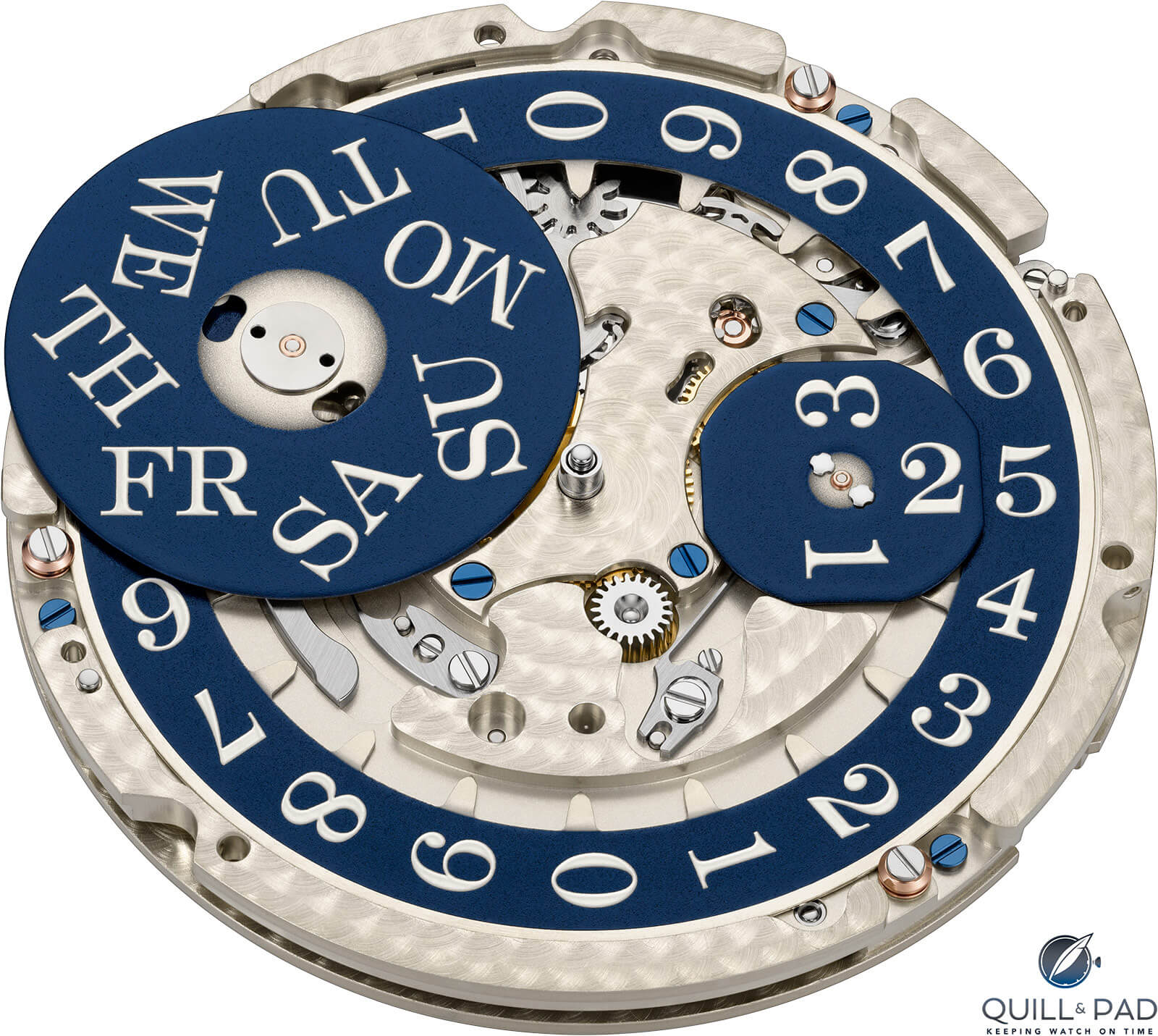
A. Lange & Söhne Odysseus large day and date mechanism
At the base of it, all the displays are built around the idea of a large ones digit ring driving the smaller tens digit, whether it’s the large date or the Zeitwerk time display.
For the large date, the system works like a combination date wheel and a jumping hour mechanism but optimized for quick jumps. With the Zeitwerk, it is initially gear driven and balanced very carefully to accommodate the significant power required to drive the mechanism, leading to all the Zeitwerk models featuring a constant-force mechanism protecting the balance from inconsistent power delivery.
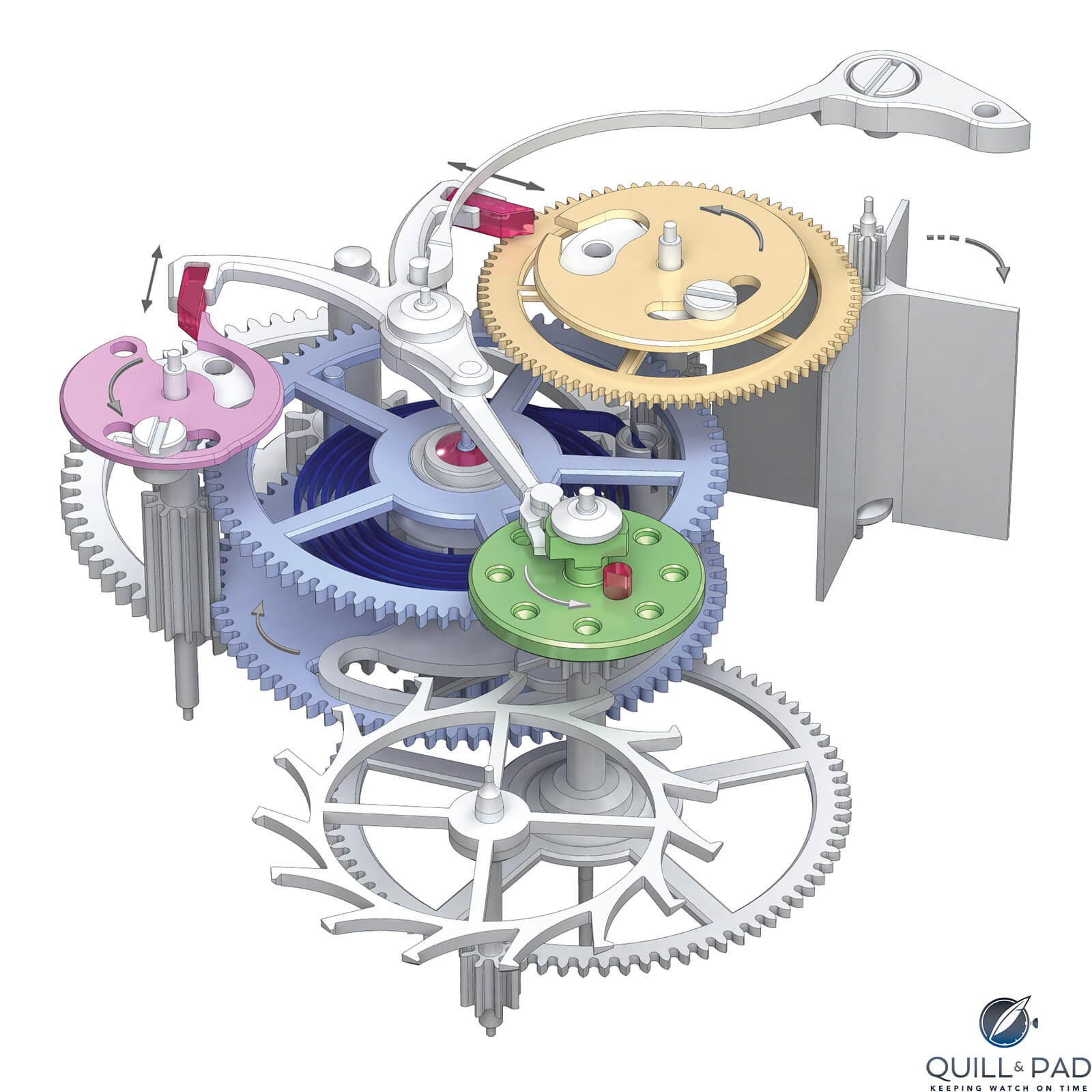
A. Lange & Söhne Zeitwerk constant force mechanism
The constant-force mechanism releases once every 60 seconds, driving the ones digit, which, over a period of ten minutes, interacts with a Geneva wheel to drive the tens digit. It’s not that simple: the tens digit is slowly charged by a small spring so that once it releases it also snaps quickly.
For the Zeitwerk and the large date, the largest digit ring (the hour ring for the Zeitwerk, the ones digit for the date) rests in a circular channel and is retained by an overlapping screw but has no central pivot. This is similar to how a date ring is usually implemented and works well with very large rings.
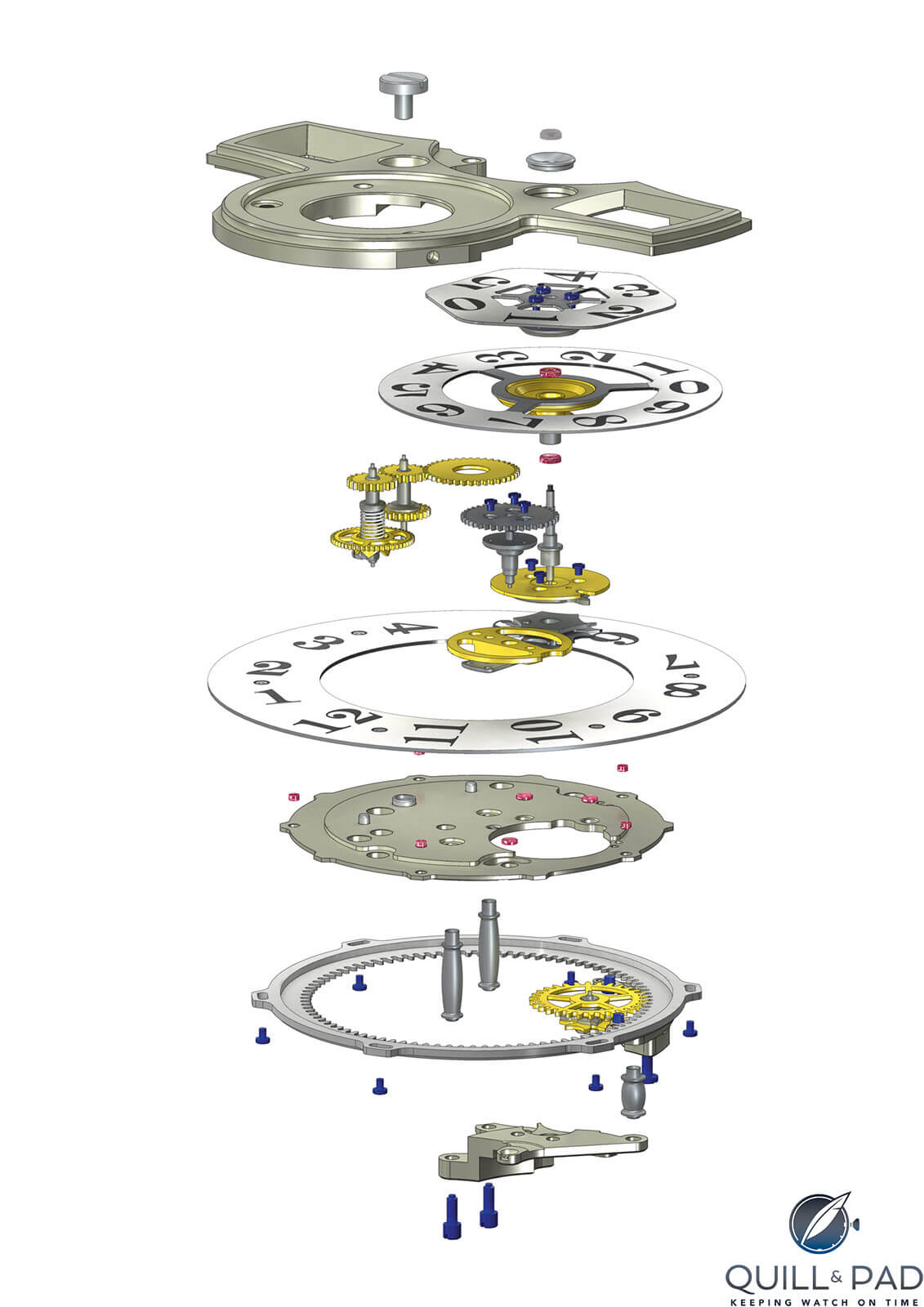
Exploded view of the A. Lange & Söhne Zeitwerk large day and date disk mechanism
Since other features need to operate within the diameter of the largest ring, it can’t have spokes that extend from a center to the edge of the ring, just like a traditional date ring.
For the Zeitwerk, the minute rings, both the ones and the tens digits, share a central pivot and are thus accurately constrained with jewel bearings. This is crucial since it needs to activate so often that anything less would add too much friction and too much play into the system. One of the challenges when designing the Zeitwerk was the very small tolerances between the digit rings. The offset between them had to be very precise to keep them as close to each other as possible (so they appear visually on the same level) but ensure they don’t get stuck on the other from any interference.
Tiny adjustments to maintain aesthetic
This was also a problem with the original large date mechanism, but with the infrequency of activation it was easier to overcome since there was more wiggle room when it came to friction.
With the new Odysseus, the date mechanism is probably the most traditional when it comes to how the rings are set up. However, there are still considerations when the size of the rings is so much larger due to the proportions of the digits and characters. The day of the week disk is driven directly by the ones digit ring of the date, again a largely traditional method, but the position of the ring due to its size was a very delicate balancing act.
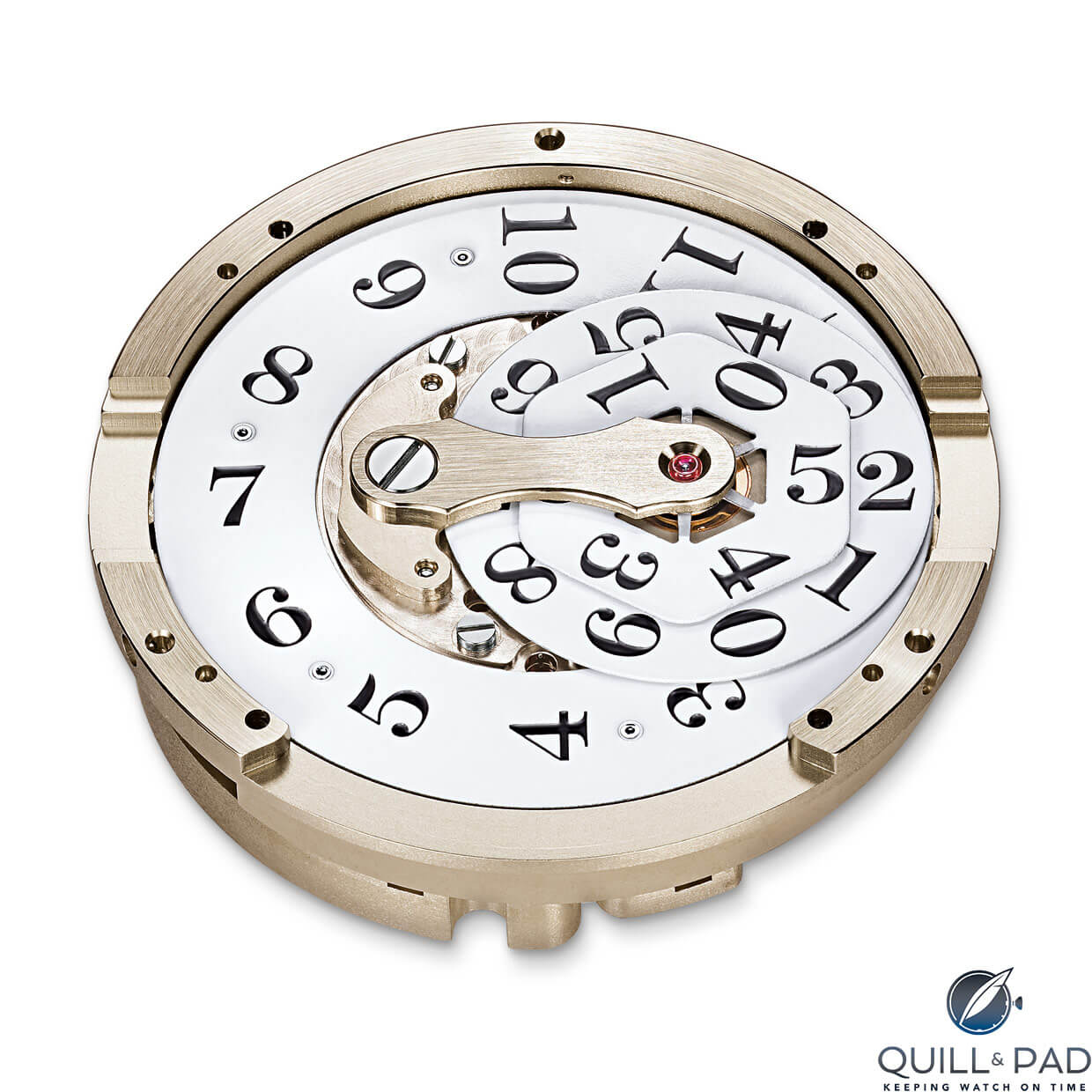
Large date disks on the original A. Lange & Söhne Zeitwerk
When we look at the diameter of the disk, it extends beyond the edge of the movement and nearly touches the central hour and minute hand pivot shafts, so the disk size was optimized to fit in the footprint of a 40.5-millimeter case.
This may seem trivial, but often the reason some movements and cases get so large is because the basic geometry of an idea can’t fit into a smaller envelope. The Odysseus is an excellent example of squeezing something into a space it doesn’t seem it should go. The large date design allows for a rather large set of digits, something that would be very obvious if it was reduced in size for a different watch.
Proportions are almost sacred to the designers at A. Lange & Söhne, and they work hard to maintain the size of features since the driving principle behind this date was very legible, large digits.
The Zeitwerk is just shy of 42 mm in diameter, which for purists and classic watch lovers becomes kind of large (let’s remember the typical size of a classic dress watch was 36 mm for a very long time). But that size was required due to the mechanical constraints of the movement.
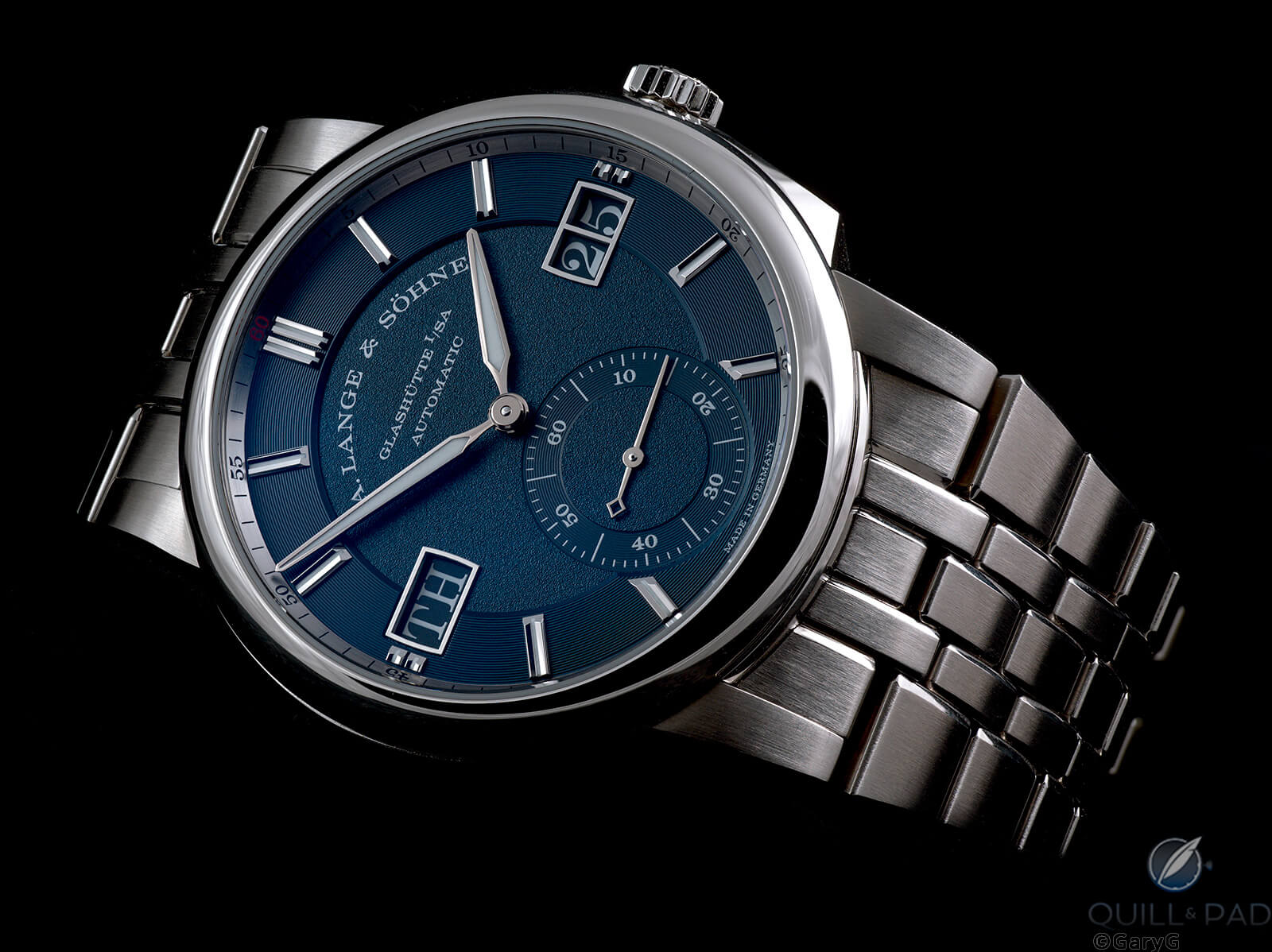
A. Lange & Söhne Odysseus in stainless steel
For the Odysseus, it is clear that the designers wanted to make a watch closer in size to the oft-quoted ideal of 39 or 40 mm.
But with a large date set at the edge of the dial opposite the day window, this made for a very tight fit since the characters needed to match in scale. The large digits of the Zeitwerk required so much power to move that even with the constant force mechanism, it historically only had a 36-hour power reserve.
Recent improvements to the movement architecture added a second mainspring barrel and optimized the mechanism to double the power reserve, but note that the decision was never to make the digits smaller and the mechanism less bold.
This shows that even the designers at A. Lange & Söhne may have hyperdigitalia as it seems clear that large digits are a fundamental building block of the brand.
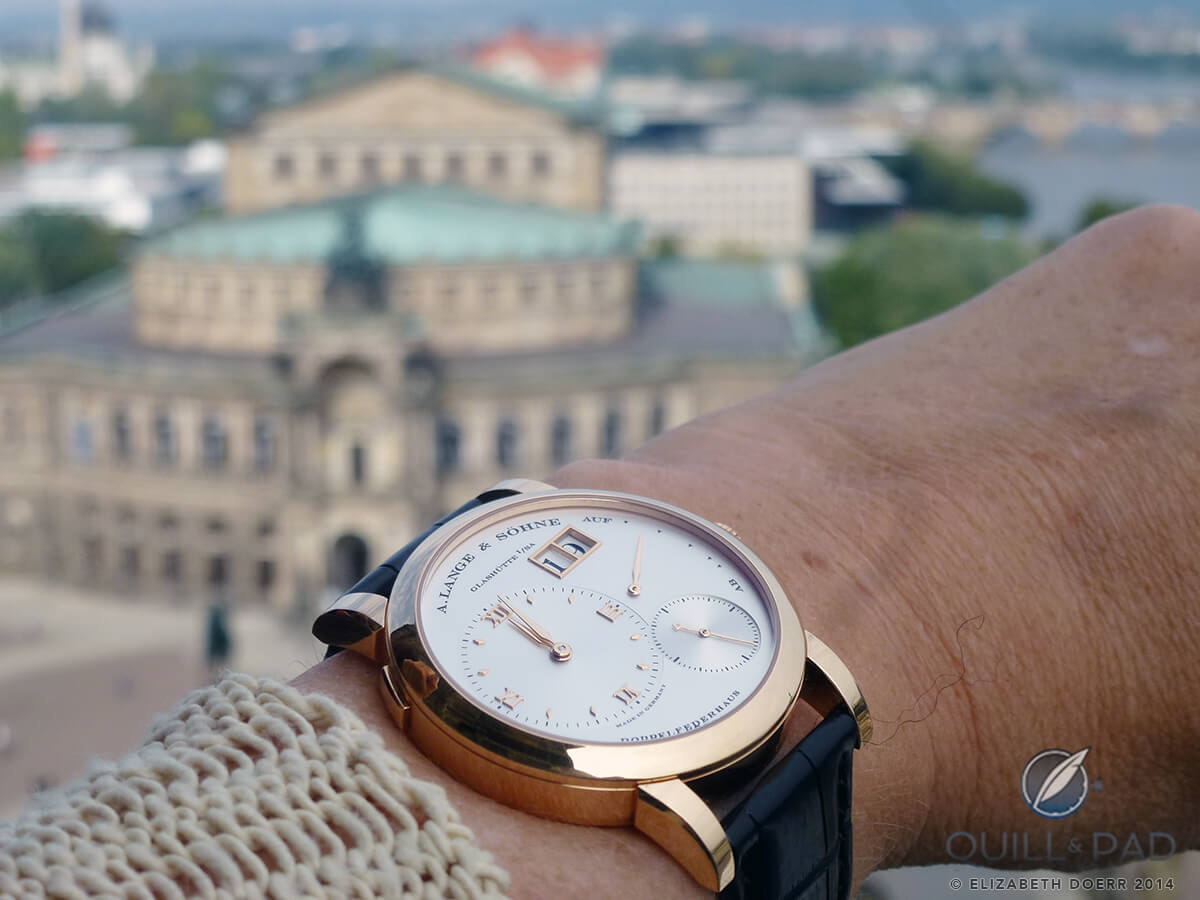
A. Lange & Söhne Lange 1 in red gold in front of Dresden’s Semper opera house
Inspired by an incredible “digital” clock with five-minute display in Dresden’s local opera house, the Semperoper, A. Lange & Söhne’s large digits have been with the brand from the beginning and show no signs of departing as a leading design principle.
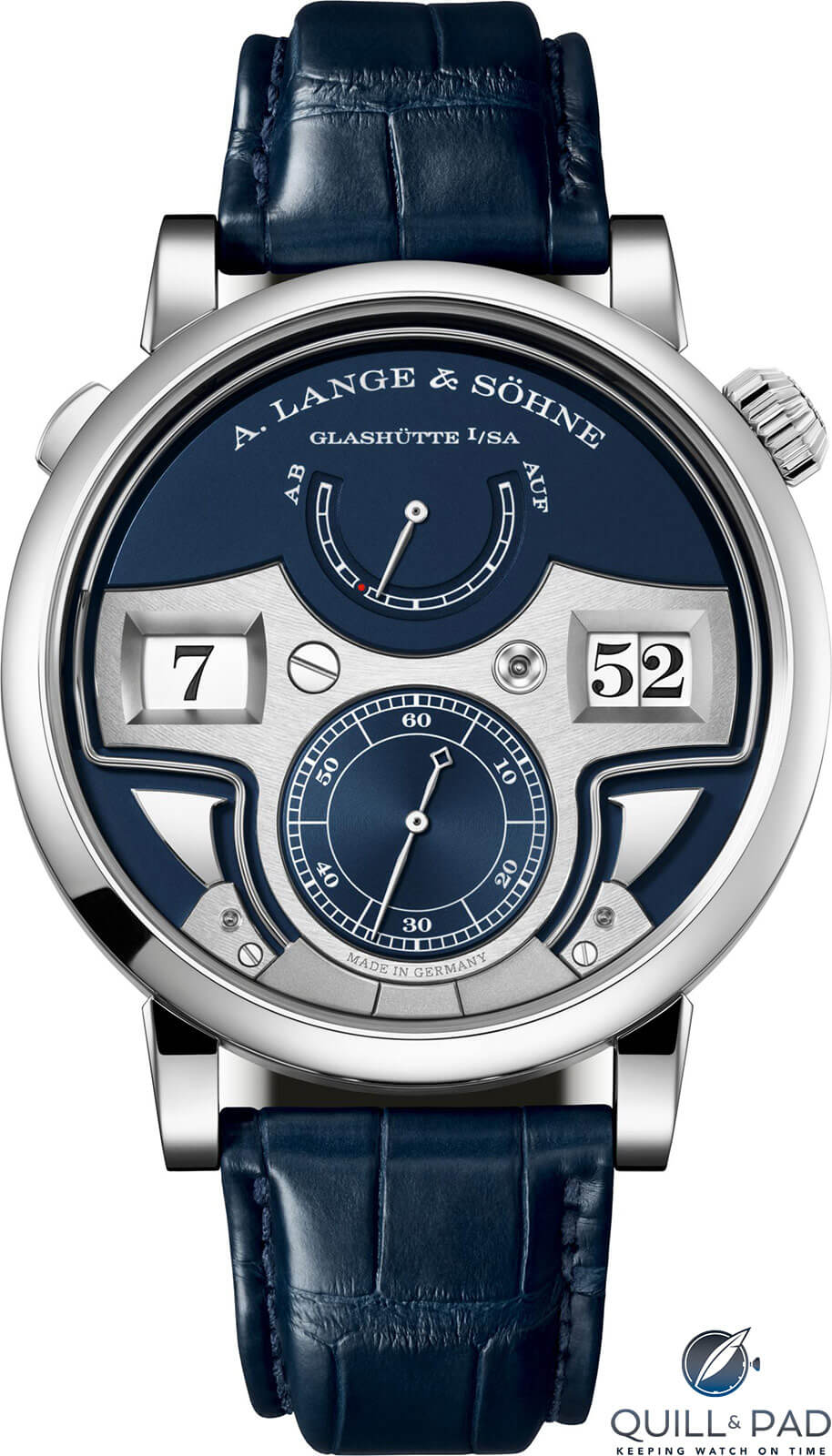
A. Lange & Söhne Zeitwerk Minute Repeater
With the addition of the Odysseus line and the continuation of the Zeitwerk with the new Minute Repeater limited edition, the prevalence of hyperdigitalia is alive and well within the hallowed halls nestled in the heart of Glashütte.
For more information, please visit www.alange-soehne.com/en/timepieces/zeitwerk-minute-repetition.
Quick Facts A. Lange & Söhne Zeitwerk Minute Repeater
Case: 44.2 x 14.1 mm, white gold
Movement: manually wound Caliber L043.5 with constant force and free-sprung balance spring; 2.5 Hz/18,000 vph
Functions: jumping hours and minutes, running seconds; power reserve, decimal minute repeater
Limitation: 30 pieces, available exclusively in A. Lange & Söhne boutiques
Price: €449,000
You may also enjoy:
Lange & Söhne Zeitwerk Minute Repeater: A Decimal Repeater With Attitude!
Sounding Off: A. Lange & Söhne Zeitwerk Minute Repeater vs. Kari Voutilainen Masterpiece 8
Lange & Söhne Zeitwerk: Digital Delight With A Mechanical Heart
Leave a Reply
Want to join the discussion?Feel free to contribute!



Hola, quisiera comprar el reloj azul.